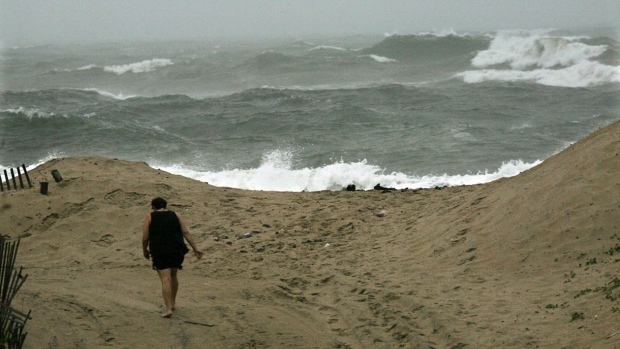Sep 11, 2018
Hurricane Florence on path to be worst North Carolina storm in 64 years
, Bloomberg News

Florence is barreling straight for North Carolina, with coastal residents fleeing what may be the most powerful hurricane to hit the state in 64 years.
Landfall is expected late Thursday or early Friday, and on its current path the eye of the storm will pass near Wilmington and the southern beach towns. More than 1 million people are evacuating amid forecasts for a 12-foot (3.7-metre) storm surge, and expectations of as much as US$27 billion in damages.
Florence is now a Category 4 storm, packing 130 mile-per-hour winds, according to an 11 a.m. update from the U.S. Hurricane Center, and it may soon re-strengthen to near Category 5 levels. It’s expected to be the worst in the region since Hurricane Hazel made landfall near the North Carolina-South Caroline border in 1954.

“Florence is expected to be an extremely dangerous major hurricane through Thursday night,” the centre said Tuesday.
The storm is currently 905 miles east-southeast of Cape Fear, North Carolina, with landfall predicted between Charleston, South Carolina and Norfolk, Virginia.
Florence “will bring extreme wind damage and surge damage,’’ said Jeff Masters, co-founder of Weather Underground in Ann Arbor, Michigan.
Florence’s storm surge threatens more than 750,000 homes in the region North Carolina, South Carolina and Virginia, according to the property analytics firm CoreLogic.
President Donald Trump on Monday night declared an emergency in North Carolina. That authorizes the Department of Homeland Security and the Federal Emergency Management Agency “to coordinate all disaster relief efforts,” the White House said in a statement. The president is scheduled to receive in-person briefings from the heads of the Department of Homeland Security and the Federal Emergency Management Agency on Tuesday.
The hurricane’s effects are already being felt in markets, with shares of home-improvement retailers Lowe’s Cos. and Home Depot Inc. rising for a second day, while insurance companies slide.
Some forecasts call for Florence to stall out after it strikes the coast. That would mean more flooding rains across a large part of the U.S. South, expanding the damage, according to Chuck Watson, a disaster modeler with Enki Research in Savannah, Georgia.
“The big problem is they are now talking about taking hurricane-force winds in as far as the Research Triangle,’’ Watson said, referring to the Raleigh-Durham-Chapel Hill area. “Pine trees tend to fracture at 70 miles per hour. That pine tree is going to wind up somewhere, maybe in someone’s living room.’’
The storm has spurred a broad range of reactions:
- The governors of South Carolina, North Carolina, Maryland and Virginia have declared emergencies.
- Power companies warned residents may be without power for days or weeks.
- Ports in the region are stowing empty containers and preparing to shift to generator power if needed for refrigeration. Port of Virginia will halt terminal activities at 11:59 p.m. on Tuesday.
- Hog and poultry companies are filling feed bins, checking generators, stocking up on fuel.
- Daimler AG and Volvo Car Group have suspended operations at factories in South Carolina because of the storm
- Further east, forecasters are watching Hurricane Helene and Tropical Storm Isaac in the Atlantic, and a patch of showers in the western Caribbean, which has a 30 per cent chance of becoming a cyclone in the next 2 days.
— With assistance by Pratish Narayanan, Chris Dolmetsch, Alex Longley, Simon Casey, Esha Dey, Janet Freund, Naureen S Malik, Mario Parker, Megan Durisin, Shruti Singh, Samuel Robinson, Chris Martin, Jim Efstathiou Jr, Ari Natter, John Harney, Heesu Lee, and Gabrielle Coppola